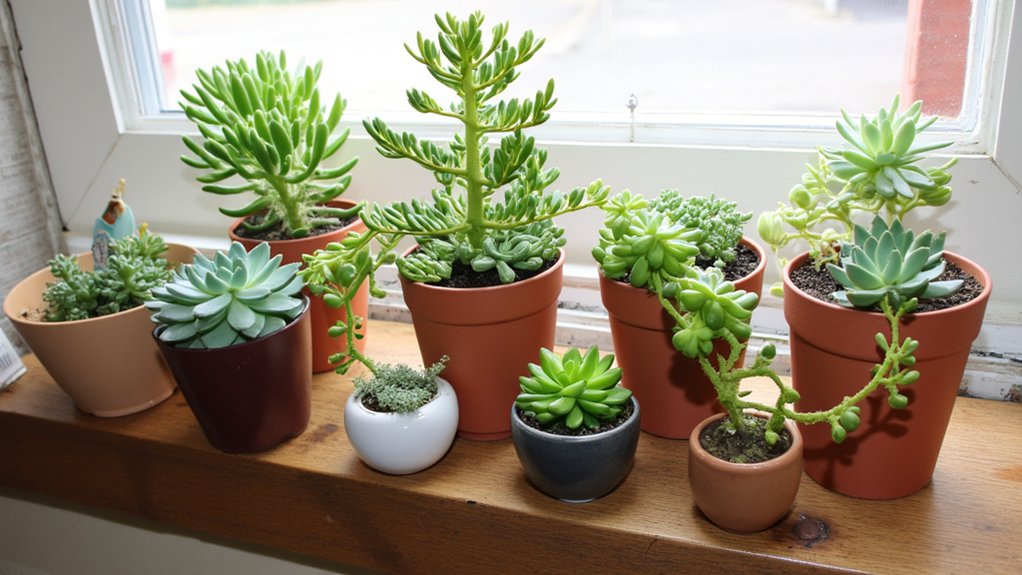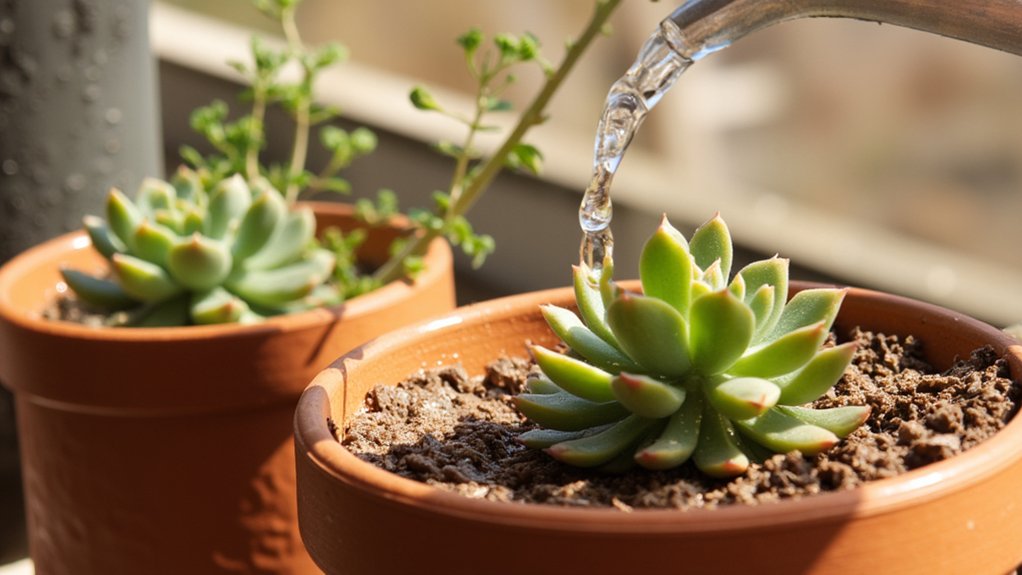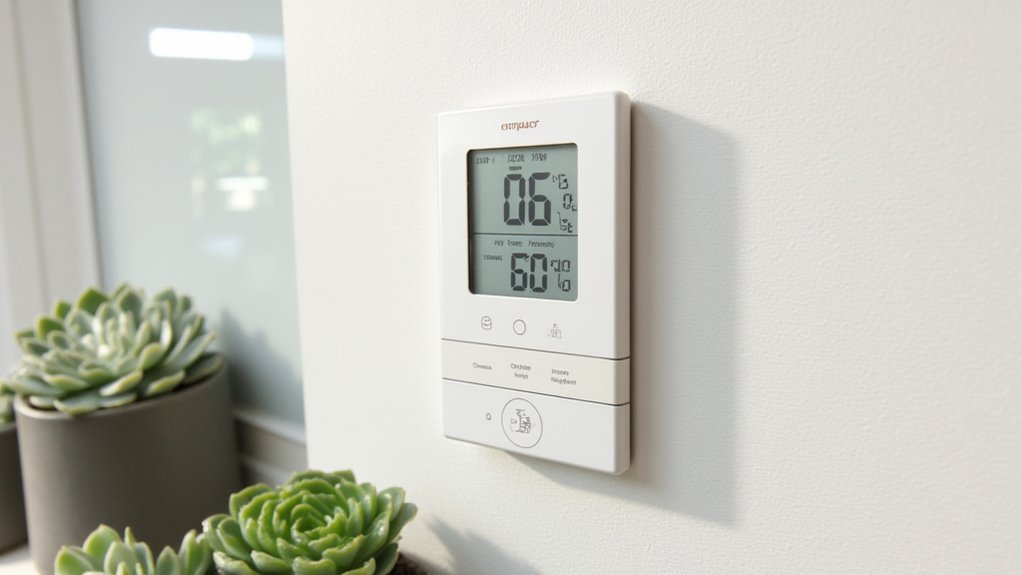Like a miniature desert oasis on your windowsill, indoor succulents can transform any room into a vibrant green sanctuary. You’ll find these hardy plants aren’t as low-maintenance as their reputation suggests – they need specific care to truly thrive in your home environment. While they won’t demand daily attention, understanding the basics of light, water, and soil requirements will make the difference between struggling specimens and stunning displays that’ll have your friends asking for gardening advice.
Contents
- 1 Choosing the Right Succulent Varieties for Indoor Growing
- 2 Light Requirements and Placement
- 3 Proper Watering Techniques and Schedules
- 4 Optimal Soil Mix and Drainage Solutions
- 5 Temperature and Humidity Control
- 6 Container Selection and Potting Tips
- 7 Fertilization and Nutrient Management
- 8 Common Pests and Disease Prevention
- 9 Pruning and Maintenance Guidelines
Choosing the Right Succulent Varieties for Indoor Growing

While there are hundreds of succulent varieties available, not all of them will thrive in your home’s indoor environment. For best results, start with hardy varieties like Haworthia, Jade Plant, or Zebra Plant, which adapt well to indoor conditions.
Look for compact succulents that won’t outgrow their space, and choose varieties that can tolerate lower light levels. Snake Plants and Aloe Vera are excellent choices for rooms with minimal natural light, while Echeveria and String of Pearls need bright, indirect sunlight to maintain their vibrant colors.
If you’re a beginner, avoid fussy varieties like Lithops or rare specimens that require specific temperature and humidity controls.
Light Requirements and Placement
Although most succulents thrive in bright light, you’ll need to be strategic about where you place them indoors. Position your plants within 6 feet of south or west-facing windows, where they’ll receive 6-8 hours of indirect sunlight daily. If you notice stretching or pale leaves, that’s a sign they need more light.
For ideal growth, rotate your containers 90 degrees every week to guarantee even light exposure. During winter months, you might need to supplement with grow lights positioned 6-12 inches above the plants. If you’re using artificial light, keep it on for 12-14 hours per day.
Proper Watering Techniques and Schedules

Proper watering is just as important as light placement for keeping your indoor succulents happy. You’ll want to water thoroughly but infrequently, allowing the soil to dry completely between waterings. During spring and summer, water every 7-10 days; in winter, reduce to every 14-21 days.
When watering, pour directly at the base until water flows from the drainage holes. Don’t let your succulents sit in standing water – empty the saucer after 15 minutes. If you’re unsure whether to water, stick your finger an inch into the soil; if it’s completely dry, it’s time to water.
Use room temperature water, and avoid getting leaves wet to prevent rot.
Optimal Soil Mix and Drainage Solutions
Since indoor succulents can’t tolerate waterlogged roots, you’ll need a fast-draining soil mix specifically designed for these desert plants. Create your own blend by combining two parts regular potting soil, one part coarse sand, and one part perlite or pumice.
For proper drainage, always use pots with drainage holes and add a layer of gravel at the bottom. If your container lacks holes, drill them yourself or insert your succulent in a plastic nursery pot before placing it in the decorative container. This double-pot method allows excess water to drain while maintaining aesthetics.
Temperature and Humidity Control

While the right soil and drainage protect your succulent’s roots, creating the perfect indoor climate matters just as much. Most succulents thrive in temperatures between 60-80°F during the day and 50-55°F at night, though they can tolerate brief temperature fluctuations.
Keep your succulents away from drafty windows and air vents, which can cause extreme temperature swings. As for humidity, these desert-adapted plants prefer dry air with 30-40% humidity levels. If your home’s too humid, use a dehumidifier or place them near a fan to increase air circulation.
During winter months, maintain temperatures above 50°F to prevent cold damage.
Container Selection and Potting Tips
Choosing the right container makes all the difference in your succulent’s growth and survival. Select pots with drainage holes that are 1-2 inches wider than your plant’s root ball, and make sure they’re made of porous materials like terracotta or unglazed ceramic.
Fill your container with fast-draining cactus soil, leaving 1/2 inch of space below the rim. When transplanting, gently loosen the roots and position your succulent at the same depth it was previously growing. Add a top layer of decorative gravel or pebbles, keeping them 1/4 inch away from the plant’s stem to prevent rot.
Fertilization and Nutrient Management
Many indoor gardeners don’t realize that succulents need far less fertilizer than typical houseplants. During the growing season (spring and summer), feed your succulents just once a month with a balanced, water-soluble fertilizer diluted to quarter strength.
In fall and winter, you’ll want to skip fertilizing altogether, as your plants enter a period of dormancy. If you’re using a commercial succulent fertilizer, look for an NPK ratio of 10-10-10 or 5-5-5, and always apply it to moist soil to prevent root burn.
Mix your fertilizer solution carefully, and remember that underfeeding is better than overfeeding with these drought-adapted plants.
Common Pests and Disease Prevention
Even healthy, well-fertilized succulents can fall victim to common indoor pests like mealybugs, spider mites, and scale insects. You’ll spot mealybugs as white, cotton-like clusters, while spider mites leave behind tell-tale webbing and tiny brown spots on leaves.
Inspect your plants weekly, using a magnifying glass to check leaf joints and stem bases. If you find pests, isolate affected plants immediately and treat them with 70% isopropyl alcohol on a cotton swab. For severe infestations, spray with neem oil solution (2 teaspoons per quart of water) every 7-10 days until pests are gone.
To prevent fungal diseases, maintain good air circulation and avoid getting water on leaves.
Pruning and Maintenance Guidelines
While succulents don’t require frequent pruning, you’ll need to trim them occasionally to maintain their shape and remove damaged growth. Use clean, sharp scissors or pruning shears, making cuts at 45-degree angles about 1/4 inch above a leaf node or junction.
Remove any dead, yellowing, or damaged leaves by gently twisting them off at the base. For leggy growth, trim stems back by up to one-third of their length during the growing season. Save healthy cuttings for propagation.
Dust your succulent’s leaves monthly with a soft brush, and remove any debris that collects in the rosettes to prevent rot and pest problems.
